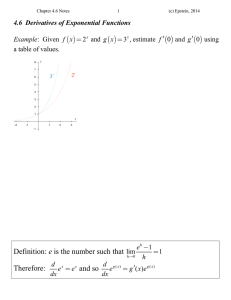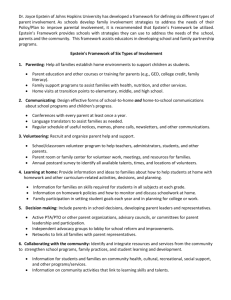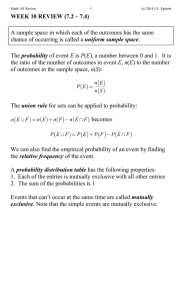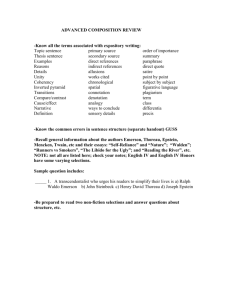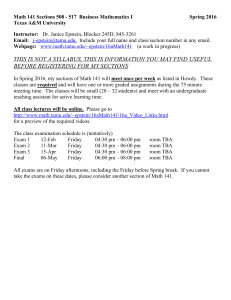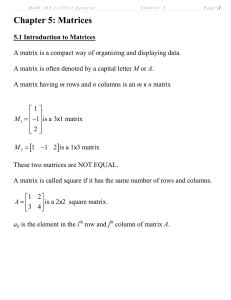WEEK 11 REVIEW (7.5 – 7.6 and 8.1 – 8.2) ( ) |
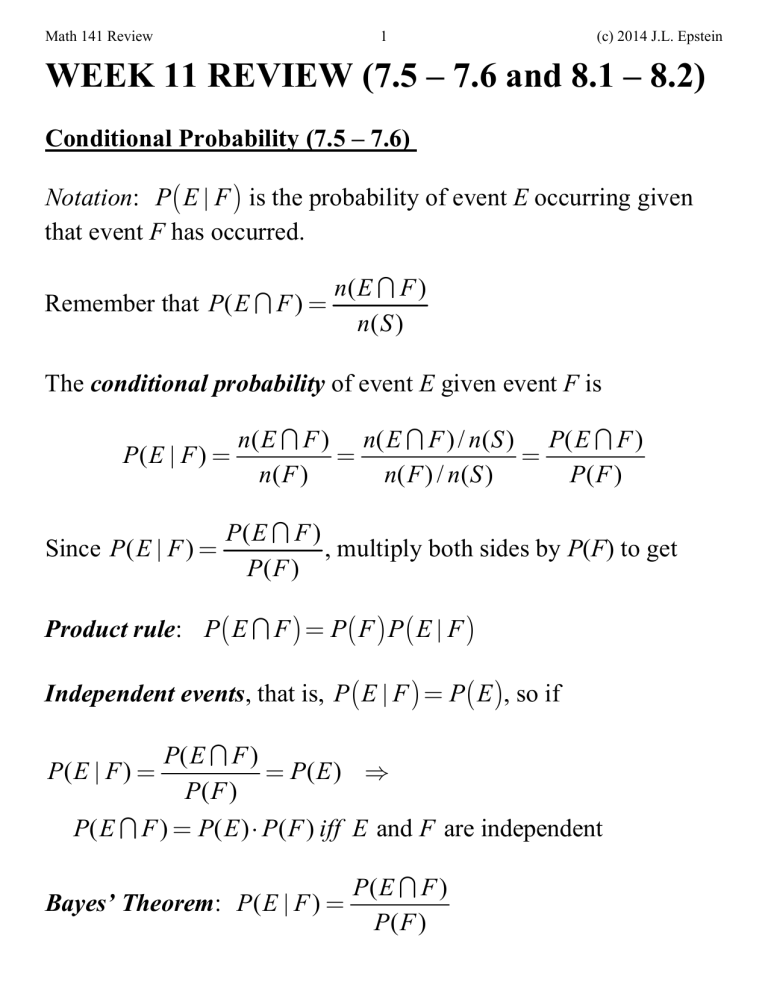
Math 141 Review 1 (c) 2014 J.L. Epstein
WEEK 11 REVIEW (7.5 – 7.6 and 8.1 – 8.2)
Conditional Probability (7.5 – 7.6)
Notation :
(
|
) is the probability of event E occurring given that event F has occurred.
Remember that (
F )
=
(
F )
The conditional probability of event E given event F is
( | )
=
( F )
=
( F ) / ( )
=
( F )
Since ( | )
=
(
F )
, multiply both sides by P ( F ) to get
Product rule :
( F
) = ( ) (
|
)
Independent events , that is,
(
|
) = ( )
, so if
( | )
=
( F )
=
( F )
=
( )
⋅
( ) and are independent
Bayes’ Theorem : ( | )
=
(
F )
Math 141 Review 2 (c) 2014 J.L. Epstein
Example: A bowl has 15 pieces of fruit and 5 of the pieces of fruit are rotten. There are 9 apples (3 are rotten) and 6 oranges.
(a) What is the probability that a randomly selected piece of fruit is a rotten orange?
(b) What is the probability that an apple is rotten?
(c) What is the probability that a good piece of fruit is an orange?
Example: Two fair five-sided dice are rolled.
(a) What is the probability that the sum is greater than 6?
1 ~ 1 2 ~ 1 3 ~ 1 4 ~ 1 5 ~ 1
1 ~ 2 2 ~ 2 3 ~ 2 4 ~ 2 5 ~ 2
1 ~ 3 2 ~ 3 3 ~ 3 4 ~ 3 5 ~ 3
1 ~ 4 2 ~ 4 3 ~ 4 4 ~ 4 5 ~ 4
1 ~ 5 2 ~ 5 3 ~ 5 4 ~ 5 5 ~ 5
(b) What is the probability that the sum is greater than 6 if at least one 3 is shown?
(c) What is the probability that the sum is 4 if both dice display the same number?
1 ~ 1 2 ~ 1 3 ~ 1 4 ~ 1 5 ~ 1
1 ~ 2 2 ~ 2 3 ~ 2 4 ~ 2 5 ~ 2
1 ~ 3 2 ~ 3 3 ~ 3 4 ~ 3 5 ~ 3
1 ~ 4 2 ~ 4 3 ~ 4 4 ~ 4 5 ~ 4
1 ~ 5 2 ~ 5 3 ~ 5 4 ~ 5 5 ~ 5
Math 141 Review 3 (c) 2014 J.L. Epstein
Example: A local clinic tests for XYZ disease. It is known that
20% of the patients coming to the clinic have XYZ disease. The test for XYZ is positive for 85% of the patients that have XYZ and it is positive for 10% of the patients that do not have this disease. a) Represent this experiment in a tree diagram. b) What is the probability that a person who tests positive has XYZ disease? c) What is the probability that a person who tests positive twice has
XYZ disease?
Math 141 Review 4 (c) 2014 J.L. Epstein
Example: Pyxie has a cell phone, an ipad and a laptop. Each morning Pyxie finds that the probability the cell phone battery is dead is 15%, the probability that the ipad battery is dead is 40% and the probability that the laptop battery is dead is 25%.
(a) What is the probability that all three have dead batteries?
(b) What is the probability that exactly one of these three devices has a dead battery?
Example: For what value of x will A and B be independent?
Math 141 Review 5 (c) 2014 J.L. Epstein
Example: A manufacturer buys items from each of 4 different suppliers. The fraction of the total number of items obtained from each supplier, along with the probability that an item purchased from the supplier is defective is given in the following table: supplier fraction of total supplied probability of defect
E 0.14 0.04
F 0.47 0.02
G 0.16 0.07
H 0.23 0.01
(a) What is the probability that an item is defective and from supplier H?
(b) What is the probability that a defective item came from supplier F?
Math 141 Review 6 (c) 2014 J.L. Epstein
Example: Draw the appropriate tree diagram for the experiments.
We choose a marble from a cup or a bowl. The probability of choosing the cup is 1/4. The cup contains 3 purple and 2 yellow marbles. The bowl contains 2 purple and 4 yellow marbles.
A bag has 3 green and 4 blue marbles. A cup has 5 green and 5 blue marbles. A marble is chosen at random from the bag. If it is blue, it is returned to the bag. If it is green, it is placed in the cup.
A marble is then drawn from the cup.
Math 141 Review 7 (c) 2014 J.L. Epstein
Statistics (8.1 – 8.2)
Example: Determine the possible values for the given random variable and indicate if the random variable is finite discrete, infinite discrete or continuous.
(a) A hand of 5 cards is dealt from a standard deck of 52 cards.
Let X be the number of clubs in the hand of cards.
(b) A kitten is weighed. Let X be the weight of the kitten in pounds.
(c) A single card is drawn without replacement from a standard deck of 52 cards. Let X be the number of cards drawn until a red card is picked.
(d) A single card is drawn with replacement from a standard deck of 52 cards. Let X be the number of cards drawn until a red card is picked.
Math 141 Review 8 (c) 2014 J.L. Epstein
Example: Use the probability distribution table below to answer the following questions.
X -2 -1 0 1 2 3
P ( X ) 0.15 0.05 0.2 0 z 0.25
(a) Determine the value of z
(b) Represent this information in a histogram.
(c) (
£
0)
(d) (
>
2)
Math 141 Review 9 (c) 2014 J.L. Epstein
The expected value of a random variable X is given by
( ) x p
1 1 x
2 p
2
+ x n
⋅ p n where x represents the values that X can have and i p is the i probability that x occurs i
Example: A raffle sells 500 tickets at $5 each. There is one first place prize awarded for $1000, two second place prizes for $100 each and 10 third place prizes at $20 each. What is the expected value of a ticket in this raffle?
Example: An Aggie ring is insured for $1200. The annual premium on the ring insurance is $15 and the probability that the ring will need to be replaced is 0.5%. What is the insurance company’s expected gain on this policy?
Math 141 Review 10 (c) 2014 J.L. Epstein
Example: A game consists of choosing two bills at random from a bag that contains two $20 bills and ten $1 bills. How much should be charged to play this game to keep it “fair” (expected value of zero)?
Example: A hand of 3 cards is dealt from a standard deck of 52 cards. Let X be the number of clubs in the hand of cards. Find the expected number of clubs
Math 141 Review 11 (c) 2014 J.L. Epstein
The odds in favor of an event E occurring is the ratio of P ( E ) to
P ( E c
) or
P E c
)
=
1
-
P E
Given the odds in favor of an event E are a : b , the probability of E a is given by a
+ b
Example: The odds in favor of selected horses in the 2009
Kentucky Derby were
Backtalk 1:14 Homeboykris 1:60 Sidney's Candy 2:15
(a) What is the probability that Backtalk will win the race?
(b) What is the probability that Homeboykris will win the race?
(c) What is the probability that Sidney's Candy will win the race?
Example: Given that ( )
=
0.4
, ( )
=
0.6
, and (
Ç
B )
=
0.3
, find the odds in favor of
(a) A occurring
Math 141 Review 12 (c) 2014 J.L. Epstein
Measures of Central Tendency
The mean of the n numbers x
1
, x
2
, …, x n
is x
= x
1
+ x
2
x n n
The median of the n numbers x
1
, x
2
, …, x n
is the number in the middle when the n number are arranged in order of size and there are an odd number of values. When there are an even number of values, the median is the mean of the two middle numbers.
The mode of the n numbers x
1
, x
2
, …, x n
is the number that occurs the most often. If no number occurs more often than any other number, there is no mode. If two numbers both occur the most often, then there are two modes.
Example
Find the mean, median and mode for the given sets of numbers
(a) 6, 3, 0, 9, 1, 9, 6, 0, 6, 6, 1, 9, 0, 3, 6, 1, 1, 7, 8, 7, 7, 4, 2, 9, 9
(b) 6, 12, 3, 14, 9, 99
Math 141 Review 13 (c) 2014 J.L. Epstein
Example: We are given the following data for the number of a certain magazine sold each week at a newsstand during the past year.
# of weeks 5 4 8 11 9 15
# of magazines 15 16 17 18 19 20
(a) Represent this data in a frequency histogram.
(b) Find the mean, median, and mode for this data.
Example: A sample of grapefruits is selected from a large shipment and the number of seeds in each grapefruit is counted.
The following results were found
# grapefruits 6 7 8 9 10
# seeds 7 6 5 4 3
Find the mean, median, and mode for this data.
